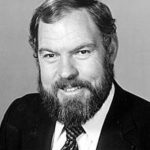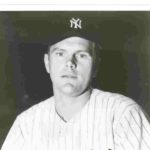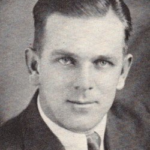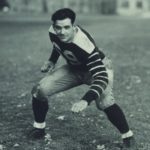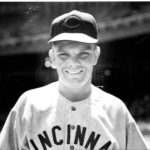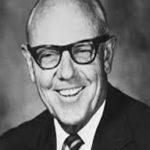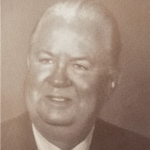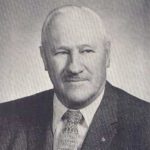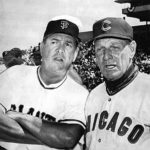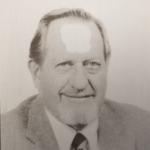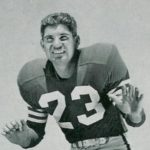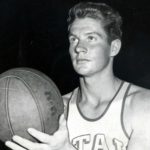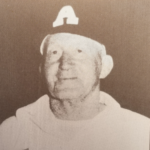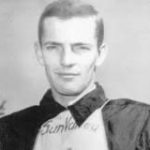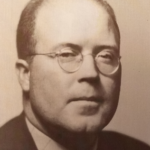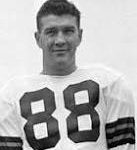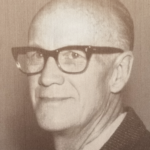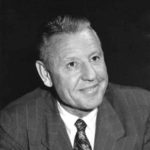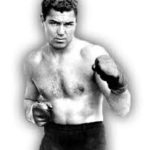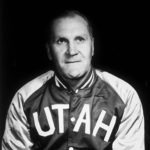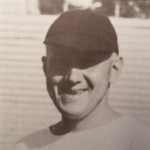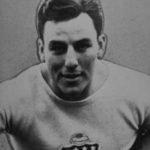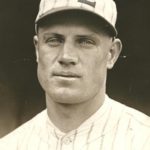HALL OF FAME HONOREES
CLASS OF 1979
Nate Long, a native of Salt Lake City, was an outstanding prep athlete at East High School and later at the University of Utah. His coaching career at South High School was the stuff of legends with the Cubs winning state championships in 1947-’48-’50-’52-’55-’66-’68. He also coached 15 region champions and four BYU Invitational individual titles and four all-around individual winners. He was selected National High School Regional Coach of the Year in 1973 and was inducted into the National Track and Field Hall of Fame in 1977. His high school coaching techniques in hurdles events led to college scholarships for many athletes.
Merlin, a native of Logan, once was acknowledged as the greatest football player ever in the state of Utah and in 1999, the Sporting News listed him as No. 25 on the list of top football players of all-time. He was a two-time All-American at Utah State and the Outland Award winner in 1961 as the nation’s top lineman. He was a first-round (No.3 overall) pick of the NFL’s Los Angeles Rams in 1962 was named NFL Rookie of the Year in 1962. He was a 14-time Pro Bowl pick and a six-time All-Pro. He was a member of the Rams’ “Fearsome Foursome” defensive line. His No. 74 was retired by the Rams. He was inducted into the College Football Hall of Fame in 1980.
George Ottinger Romney, always known as “Ott,” was a native of Salt Lake City and attended the University of Utah from 1910-1912. His college coaching career took him to Montana State in Bozeman, where he was head coach in both football and basketball. He moved on to Brigham Young University in 1928 and became the Cougars’ third head football coach, posting a 44-31-6 record over a nine-year career. His best team went 8-1 in 1932. His overall career football record was 72-51-8 and 232-102 in basketball. After coaching, he was BYU’s athletic director and later directed President Dwight Eisenhower’s National Fitness Program and served as National Chairman of the American Red Cross.
CLASS OF 1978
John spent 51 years in sports journalism, spanning seven decades from 1939 to 1990. A native of Waverly, Iowa, and a varsity swimmer and boxer for the University of Iowa Hawkeyes, he joined the Salt Lake Telegram in 1939. He became Sports Editor of The Salt Lake Tribune in 1948 and wrote as many as six columns a week. He was elected president of the Football Writers Association of America in 1969 and was instrumental in having U.S. President Richard M. Nixon present the national football title in Fayetteville, Ark., to the University of Texas, the first sitting president to ever award the trophy in person. In 1986, he became a member of the National Honors Court that picked football College Hall of Fame members.
Fred, a Salt Lake City native, was an outstanding all-around athlete at West High School, most notably in baseball. He signed a pro contract with the St. Louis Browns in 1939 and played seven years in the Major Leagues, with the Browns and New York Yankees. He played for the Browns from 1943-47 and with the Yankees in 1949-50. He was 12-7 overall with the Yanks, including a 3-0 mark and 2.31 ERA in a September run that led to the Yanks’ World Series win over Brooklyn. He was 4-0 early in 1950 and helped N.Y. to another pennant and World Series win over the Philadelphia Phillies. He won two championship rings, although he didn’t appear in a World Series game. He was one of the top fielding pitchers, ranking second in fielding in 1948.
Preston (“Pres”) Summerhays was born in Farmington and became one of the University of Utah’s top all-around athletes and coaches. He was All-Rocky Mountain Conference for four years as a triple threat in football. He was head baseball coach for the Utes for 21 seasons and was honored by the American Baseball Coaches Association for meritorious service. He coached the Ute Ski team to two NCAA championships and was an assistant Ute football coach for 15 years. He served on the National Rules Committee for college baseball. He was inducted into the ABCA Hall of Fame in 1983.
Elmer, a native of Willard, Utah, was known as “Bear” from the time he competed for Box Elder High School in Brigham City through his collegiate career at Utah State University and a professional football career with the Detroit Lions. He was named the first-ever Utah State All-American in any sport in 1934 by the Newspaper Enterprise Association. He was USU’s nominee for Sports Illustrated’s Silver Anniversary Team. He played 11 games during the Lions’ march to the National Football League championship over the New York Giants in 1935. He received the State of Utah’s Amateur Athlete of the Year award in 1934 and was inducted into the USU Hall of Fame.
CLASS OF 1977
The “Fox” will rank among the top coaches in University of Utah basketball history, and in view of Jack’s induction into the Naismith Hall of Fame, a top coach in the entire nation. He was captain of his University of Southern California team and found his first collegiate coaching job at Kansas State University, where he piloted three conference champions and took the Wildcats to the Final Four in 1948 and 1951. He became Utah’s head coach in 1953 and once again, guided the Utes to a pair of Final Four appearances (1961 and 1966) and seven league titles. He ranks in the top 10 in college coaching with 649 wins and only 278 losses. He is also in the Helms Hall of Fame and a recipient of the National Association of Basketball Coaches Golden Anniversary award.
Jay, a native of Helper, became an all-around athlete at Lehi High School and moved on to the University of Utah, where he was active as a boxer. His ring tutelage came from legendary trainer Marv Jenson. Jay won the National Golden Gloves title and the Amateur Athletic Union heavyweight titles in 1947-48. His career highlight was selection to the U.S. Olympic boxing team in 1948 in England, where he advanced to the quarterfinals. He turned pro for one year to finance his medical career. He had a 8-3-1 professional ring record and once fought heavyweight boxing champ Joe Louis in an exhibition bout. He spent 40 years as a ringside physician for thousands of boxing matches.
Kent was a native of Goshen, Utah, but competed at South High School, where the hard-throwing left-hander led the Cubs to the 1944 state championship. The South High career led “Pete” to a contract with the National League’s Cincinnati Reds in 1944. He played one season and served three years in the military while pitching for the Manila Dodgers. He returned to pitch for the Reds from 1947-1952. He finished his career with the Philadelphia Phillies in 1953. He posted a career pitching record of 13-38 with a 4.95 earned-run average and 208 strikeouts. He set a National League record of six hit batsmen in 137 innings while with the Reds.
 Dale Schofield
Dale Schofield
Track and Field
Dale was born in Salt Lake City and went on to attend Brigham Young University, where he became one of the school’s all-time track stars. He captained BYU’s track team that won the conference championship in 1936. He was undefeated in the low and high hurdles in collegiate dual meets. He set conference records in the low hurdles (23.3 seconds), and AAU records in the 100-meter dash and 200-meter hurdles. He set an AAU national mark in the low hurdles in 1936. He was selected to the 1936 U.S. Track and Field team for the Berlin Olympics as a teammate of the legendary Jesse Owens. After the Olympics, he won a number of titles in sprints and in both low and high hurdles events.
Stan was a native of Murray and was a top-flight, all-around high school athlete and later competed at BYU from 1936-38. He had a distinguished high school coaching mark and in 1947 joined the BYU coaching staff and in 1949 took the head basketball coaching job. He posted a career mark of 371-254 from 1949-1970 and was one of six collegiate coaches to win 100 games in his first five years. He won eight conference titles. His teams were in 11 postseason tournaments, winning the NIT championship in both 1951 and 1966. He was a 1986 Naismith Basketball Hall of Fame Inductee and was president of the National Basketball Coaches of America in 1970.
CLASS OF 1976
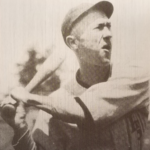 Spencer “Sparky” Adams
Spencer “Sparky” Adams
Baseball
Spencer, known to all as “Sparky,” was born in Layton and was a standout athlete in high school. He was signed to a Major League contract in 1923 and would play in 180 Big League games, starting with the Pittsburgh Pirates in 1924. He was with the Washington Senators in 1925, the New York Yankees in 1926 and the St. Louis Browns in 1927. He was on the Yankees’ team with Babe Ruth in 1926 that lost to the St. Louis Cardinals in a seven-game World Series. He had a career batting mark of .256 with 38 RBIs and a .324 on-base percentage. The national publication, Baseball Digest, once referred to “Sparky” as a “slick fielding second baseman from Utah.”
Joe, a Provo native, was Utah’s bowling phenomenon in a three-decade run in the 1940s, ’50s and ’60s. Evidence is ample, including 40 major tournament wins between 1940-1960 in both singles and doubles events. His career included three perfect 300 games at a time in bowling history when the 12-consecutive-strike accomplishment was akin to winning the lottery. Joe participated in seven American Bowling Congress tournaments. He was inducted into the Utah State Bowling Association Hall of Fame in 1997 and is a member of the Ogden Bowling Hall of Fame. He served a two-year term as president of the Utah State Bowling Association. Joe was also an outstanding semi-pro pitcher for many years in Utah leagues.
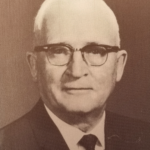 Rulon “Bunny” Clark
Rulon “Bunny” Clark
Basketball
Rulon, who was born in Farmington, was known affectionately in Davis County as “Bunny.” A standout high school athlete and a near straight-A student, Clark went on to the University of Utah, where he was a part of basketball history. He captained the Ute hoops squad that swept into Chicago in 1916 and shocked the country with a 28-27 victory over the Illinois Athletic Club for the National Amateur Athletic Union national championship. Clark’s Utes had previously beaten the defending AAU national champion, San Francisco Olympic Club. The national title was the first for any Utah school in any sport. A 1920 U. grad, the eventual Utah Juvenile Court judge of 26 years earned his law degree from Chicago’s La Salle Extension College.
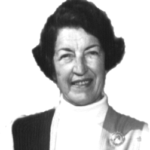 Hortense Wood Hardesty
Hortense Wood Hardesty
Trap Shooting
She was the Utah sharpshooter of the century, earning plaudits for her accuracy in the Beehive State. Then, she moved on to the national stage, ultimately gaining a coveted spot in the American Trap Shooting Hall of Fame. She is one of only 25 women in the Hall of Fame. She was named to the All-America trap shooting team for 15 years. She captained the Ladies All-Star team for seven years. Hortense was only the second U.S. woman to reach a 27-yard handicap rating. She set a ladies record by breaking 973 targets out of 1,000 in a one-day match. She won the 1962 Grand American title and the Grand American 16-yard title in 1955.
He was called “Tuck” or “Curly,” but the one name Wayne called everybody else was “Heber.” Tucker was one of the greats to come out of Lincoln High School in Orem, winning 13 letters in various sports. He has been called one of the greatest third basemen in fastpitch softball history. He was the first Utahn to gain All-America softball honors for three years. He was a playing manager whose teams won regional titles five times and played in five world tournaments, finishing third in 1939. He signed a pro contract with the New York Yankees in 1944 and spent 18 years in the Yankee system as a player-manager. He has been inducted into four Halls of Fame.
CLASS OF 1975
In the “Hot Stove” conversations, those winter-time baseball enclaves of yore, the name Claude Engberg and Pioneer League are synonymous. A longtime catcher and manager in many Utah semi-pro leagues, the accomplished businessman was instrumental in the formation of the Pioneer League in 1939 and served two terms as its president, 1953-1965 and 1970-1974. He was named an Inaugural Executive in the Pioneer League Hall of Fame and the league anointed him “President Emeritus” for life. He served as general manager of the Salt Lake Bees. He was a longtime member of the Major-Minor League Executive Committee.
Willard Baugh “Butch” Knowles was among the all-time outstanding athletes at Logan High School, and carried those multi-sport credentials on to Utah State University. The football, basketball, track and wrestling standout, who would amass 10 letters as an Aggie, carved his most noteworthy niche in football. He was named to the All-Rocky Mountain Conference football team four years and was nicknamed the “Utah Aggie Thunderbolt.” One national publication referred to him as “The Red Grange of the RMC.” He went on to an honors-laden career in high school education, mainly in California. The Alhambra High School football field in Martinez, Calif., bears his name.
 Fred Sheffield
Fred Sheffield
Track and Field/Basketball
Fred, a Kaysville native, was an all-around high school star athlete at Davis High School. At the University of Utah, he achieved national acclaim. He was the captain of the Utes’ basketball “Blitz Kids” who took the nation by storm in 1944 by defeating Dartmouth for the NCAA championship and then upset NIT champion St. John’s in New York City’s Madison Square Garden. He was the NCAA high jump champion in 1943-1945 and won the Amateur Athletic Union high jump title in 1945. He played one year in the NBA with the Philadelphia Warriors, but dental school duties ended his hoops career. He rose to the rank of Colonel in the U.S. Army medical division.
CLASS OF 1974
Helen was the first female to be inducted into the Utah Sports Hall of Fame. She gained her stardom mainly through defeating the world-famous “Babe” Didrikson Zaharias in the semifinals of the 1939 Western Open. Helen was an all-around athlete who excelled in bowling, softball, basketball and swimming and diving. Golf was her hallmark sport with six Utah State Women’s Amateur titles to her credit. In 1925, she won every women’s golf tournament in Utah. In 1947, she was accorded the Pioneer Centennial Award as the outstanding woman athlete of the state’s first century.
Herman, a native of Price, was a graduate of East High School in Salt Lake City and attended the University of Utah. He signed a professional baseball contract in 1939. He played eight years in the Major Leagues with the Brooklyn Dodgers, San Francisco Giants, Philadelphia Athletics and St. Louis Cardinals. He was a catcher in 188 Big League games and was on two pennant-winning Giants’ teams (1951 and 1954) and the Giants’ World Series team of 1954. He managed the Giants for four seasons, finishing a total of 3 ½ games behind the Dodgers over two years. He managed the Chicago Cubs for two years. His managing record was 601-521 (.537).
Clint was one of the most accomplished track athletes of his day. He was a native of St. George and graduate of Dixie High School, where he was an outstanding all-around performer. At Brigham Young University, he became the world’s top feet-first high jumper. He broke his first high jump record in a 1914 high school meet. At BYU, he won eight first-place medals in a single meet. In the 1917 Penn Relays, he set a world high jump mark of 6-feet-5 3/8 inches, a mark that stood for 17 years. He also set an unofficial world record of 6-feet-7 3/8 at BYU. During his Army service in World War II, he was noted as the best all-around athlete in the history of the Army. He served as a vice-chairman of the National Amateur Athletic Union in track and field.
Linn was the most outstanding Utah tennis competitor in the state’s first century. The Salt Lake City native, who earned his tennis stripes at Liberty Park, was a collegiate star at Brigham Young University, where he earned two degrees. In the Marine Corps, he won a boxing title. Then, it was back to tennis where he won three National Public Park championships during the decade of the 1930s. He earned a doctorate in education at the University of Utah. He was a 1964 inductee in the National Public Parks Hall of Fame. Linn was a perennial winner of the Utah, Idaho and Intermountain Tennis Championships and a lifelong tennis instructor.
CLASS OF 1973
Rex was born in Moab, but played high school sports at Carbon High School in Price where he starred in football, track and baseball and became known as the “Carbon Comet.” At Brigham Young University, his exploits as a halfback in football made him an All-Rocky Mountain Conference selection. He was the San Francisco 49ers’ 14th-round pick (No. 162 overall) in the 1951 draft. He played six seasons for the 49ers and was elected team captain in 1956. He was selected to the NFL All-Pro team as a defensive back.
Vern Gardner was a 6-foot-5 center/forward in basketball at Star Valley High School in Afton, Wyoming. The neighboring University of Utah was the beneficiary of his collegiate talents. He became a two-time consensus second-team All-American in 1947 and 1949 at Utah. He led the Utes to the ’47 National Invitation Tournament championship and was named Most Valuable Player. He was a 1949 National Basketball Association first-round draft pick, and No. 6 pick overall, by the Philadelphia Warriors. He averaged 8.9 points per game over three years. His No. 33 was retired by Utah.
Edward Burlton Heusser was a Salt Lake City native who rose to Major League stardom as a hard-throwing right-hander. He pitched part of nine seasons with the St. Louis Cardinals, Philadelphia Phillies, Philadelphia Athletics and Cincinnati Reds. His banner season was 1944 when he posted a 13-11 record with Cincinnati and led the National League with a 2.38 earned run average. He amassed a 56-67 Major League record with 266 games and a career ERA of 3.69. He had a 19-3 record in 1947 with Montreal of the International League. He was nicknamed “The Wild Elk of the Wasatch.”
George “Doc” Nelson was a native of Norway and found his way into Logan and Cache Valley in the early 1920s. He had been a professional wrestler and competed in more than 1,000 matches. But his calling at Utah State Agricultural College was to be in collegiate wrestling. He was charged to start a wrestling program at the USAC in 1922. That coaching career would last 37 years until his retirement in 1959. During that time, he was also the Aggie trainer and was noted in a Los Angeles Times article as a great name in collegiate wrestling. His nickname was “The Fighting Fireman.” USU’s basketball arena was named George Nelson Fieldhouse.
Jack was a graduate of Granite High in Salt Lake City and the University of Utah. The man known as “Red Dog” because of his hair color was one of the top all-around skiers in the U.S. from 1939 and represented his country in the 1948 Olympic Games in St. Moritz, Switzerland, and was captain of the U.S. Olympic Ski Team for the 1952 Games in Norway. His best finish was seventh in the slalom in 1948 although he also skied the downhill and combined. He won the 1952 Olympic Trials at Sun Valley. He was the youngest (14) person ever to soar off the Ecker Hill jump in Parleys Canyon. He was an inductee into the National Ski Hall of Fame in 1969.
CLASS OF 1972
Douglas “Frankie” Borg, one of the most well-known amateur athletes in Utah history, graduated from South High School and went on to the University of Utah. He began a storied 30-year fastpitch softball career in 1938 and hurled over 1,200 games through retirement in 1967. He was on six state championship teams, won 10 Metro titles in 16 years, and led teams in nine National Tournaments, finishing as high as No. 3 in 1952, the year he became Utah’s first All-America pitcher as the MVP of the tournament. He threw numerous no-hitters and once pitched four consecutive shutout games and pitched (and won) three games in one night three times. He was saluted as Utah’s “Mr. Softball” for his career that also included numerous batting and home run titles.
Fred, always known as “Buck,” was one of Provo High School’s all-time all-around athletes and continued his brilliant career by winning 15 varsity letters at Brigham Young University in football, basketball, tennis and track. He was all-conference in football, basketball and tennis. He won the Intermountain tennis singles title five times. He organized BYU’s first golf team and was the Cougars golf coach from 1947-61. He coached the Y.’s tennis team for 45 years with his netters winning several state titles. “Buck” was Physical Education Department Director at BYU.
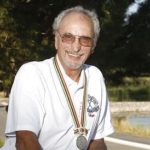 Blaine Lindgren
Blaine Lindgren
Track and Field
Blaine hailed from Magna and was a Cyprus High School graduate and a University of Utah track standout. As a Ute, he dominated the Skyline Conference by winning both the high and low hurdles races three straight years. He placed third in the 1961 NCAA high hurdles and took second in the high hurdles in the National AAU meet. He set a Pan American Games high hurdles record in 1963. Blaine will be remembered best as the silver medalist in the 1964 Tokyo Olympics. He would have won the race over Hayes Jones, but he leaned under the finish tape. It was the only time Jones beat Lindgren in any hurdles event.
Mac Speedie was an all-around athlete at South High in Salt Lake City, starring in football, basketball and track. He was All-Rocky Mountain Conference in football at Utah from 1939-41. Following a stint in the Service, he launched a six-year pro football career with the Cleveland Browns. He was a four-time All-Pro selection and made the first-ever NFL Pro Bowl in 1950. He set a Browns record with 11 catches in one game, gaining 247 yards, and held the Browns mark of 67 catches in a season. He was named to the NFL All-Decade team of 1940-49.
CLASS OF 1971
Louie was a standout athlete at Ogden High School, where he captained the football and baseball teams. At Utah State University, he excelled as Aggie quarterback during the early 1920s. He was captain of the 1920 and 1921 football teams and was picked All-Rocky Mountain States Conference quarterback for three seasons. Sports Writers across the nation recognized his accomplishments by selecting him one of the nation’s Top 10 quarterbacks. Falck also won letters in baseball and track for four years.
Walter Creed Haymond was a Springville native who set many high school sprint records. He went on to the University of Utah, where he continued his career of dominating the sprints. His career really blossomed at the University of Pennsylvania, where he completed his School of Dentistry studies. In 1915, he set a world record of 22.5 seconds in the 220-yard dash around a curve. The same day, he competed against many of the nation’s best sprinters and won the 100-yard dash. He was a member of the U. of Penn team at the Penn Relays that set four world records.
Eddie was a four-sport letterman at Brigham Young University, a 150-pound competitor who captained the 1925 football team and played every minute of every game for 2 ½ years. He coached at Millard High School and later at Jordan High, where his team won both state and southwest titles. He served as head football coach from 1937 to 1941 and from 1946 to 1948 with a 34-32-8 record. He went back to BYU where he coached BYU basketball for four years with a 59-38 record. He was also BYU athletic director from 1937-1963. He helped organize the Mountain States Conference and was named Coach of the Year in 1938 and 1941. He served as Director of Physical Fitness and Training for the Navy during World War II.
Bud will always be remembered as the collegian who brought the Brigham Young University swimming program out of the dark ages and onto the national scene in the late 1920s. He earned All-American honors and that was really noteworthy in the early years. He was high point man in every swimming event in both his high school and college careers. And he amassed the most points in the 1928 and 1929 NCAA meets, earning him “Outstanding Swimmer” honors both years. His All-American honors were awarded for his record setting performances in the 220-yard and 440-yard races.
CHARTER CLASS OF 1970
Ike played football for Drake University before becoming the University of Utah’s head coach in 1925. He compiled a 24-year record of 141-55-15. He had two undefeated seasons (1928 and 1941) and three undefeated and untied seasons (1926, 1929 and 1930) and won six Mountain State Conference titles. He coached Utah to its first bowl win, 26-0 over New Mexico in 1939. As the U. athletic director, he helped promote construction of the 20,000-seat Ute Stadium and Einar Nielsen Fieldhouse. After the 1949 season, he became athletic director at the University of Minnesota. Ike was inducted into the College Football Hall of Fame in 1957.
Frank was a three-sport star at Granite High School in Salt Lake City, excelling in baseball, basketball and football. Nick-named “Crashing Chris,” he played fullback for the University of Utah and was the school’s first three-time All-American as a first-team selection in 1932. The Utes posted a 21-3-1 record in his three years. He holds the school’s all-time career scoring mark with 235 points, scoring 100 points in 1930. He once scored 13 points in 13 seconds vs. Colorado College. Frank played three seasons with the Detroit Lions of the National Football League (1934-37) and was on the Lions’ 1935 World Championship team. He was inducted into the College Football Hall of Fame and was honored as a Silver Anniversary All-American by Sports Illustrated. He became world famous in business as an innovator in the diamond drill bit field.
William Harrison “Jack” Dempsey lived in Utah for several of his teenage years. He fought a number of boxing matches in Utah under the name “Kid Dempsey,” although he was most frequently known as “Kid Blackie” and the “Manassa Mauler.” He competed from 1914 to 1927. He was Heavyweight Champion of the World from 1919 to 1926. He was the first million-dollar boxing wage earner. He upset Jess Willard for the heavyweight title in 1919 and ruled as champ until 1926 when he was upset by Gene Tunney. Their rematch in Philadelphia, the “Long Count Fight,” generated a reported $2.6 million in gate receipts. Dempsey was inducted into the International Boxing Hall of Fame in 1954.
Alf was the first-born son of one of Norway’s all-time famous skiers, Trond Engen. Being famous ran in the Engen family. Alf came to America in1929, first settling in Chicago and soon finding himself in the Wasatch Mountains of Utah. It was ski jumping where he established his identity, but he quickly mastered Alpine skiing and is credited for developing the technique of powder skiing, honed at the world famous Alta Ski Resort. In 1940, Alf won the National Four-Way in Seattle for ruling in the downhill, slalom, ski jumping and cross country. He won the Canadian Four-Way three years running, 1939-40-41. He was the North American ski jump champ. Alf was a member of the 1940 U.S. Olympic Ski team and was the 1948 U.S. Olympic Ski Coach. He was honored by the Helms Hall of Fame in 1954 and entered the Skiers Hall of Fame in 1956. He was named Utah’s Athlete of the 20th Century by The Salt Lake Tribune in 1999.
The native of Ogden and a star at Ogden High School will be forever known as one of the University of Utah’s “Blitz Kids,” who made basketball history in 1944 with a whirlwind, 48-hour double championship in New York’s storied Madison Square Garden. Arnie was a four-time All-American as a Ute and ultimately was the 33rd pick in the 1947 NBA draft by the Minneapolis Lakers, and he played for two championship teams. The years 1944 and 1947 define him best. Arnie was named Most Outstanding Player of the 1944 NCAA tournament in which the Utes beat Dartmouth 42-40 in overtime and 48 hours later, beat NIT champ St. John’s in a Red Cross Benefit game, 43-36. After service to his country, he was on the Utes’ NIT title team of 1947, again winning in the fabled Garden, this time against Kentucky. He is in the Helms Basketball Hall of Fame. He served as Ute athletic director from 1978-86.
He was known as “Mr. Tennis” in Utah and for good reason. Dave Freed launched a junior tennis program in his home state in 1956 and thousands of aspiring players have emerged to enjoy the game. Freed, a standout player at East High School and the University of Utah, won myriad tennis titles in the Intermountain West and in 1954, at age 45, won the National Senior Singles title at famed Forest Hills in New York. He was captain of the U.S. Davis Cup Team in 1960. He and his partner won the National Clay Court Doubles championship. Dave was the leader and developer of the Salt Lake Swimming and Tennis Club.
He was the West Jordan “Mauler,” or “Brawler,” but by any name, Gene Fullmer was unquestionably the best Utah-born boxer ever. From an accomplished boxing family that included brothers Don and Jay, Gene fought his way through western rings and after a whirlwind, undefeated tour of New York venues, he got a shot at the World Middleweight Championship and beat the famed Sugar Ray Robinson for the title in New York on Jan. 2, 1957. He would fight Sugar Ray four times, with two wins, a loss and a decision vs. boxing’s “Fighter of the 20th Century.” Gene beat Carmen Basilio for the vacant Middleweight title in 1959 and finally lost the title to Dick Tiger in 1962 in Nigeria. He compiled a 55-6-3 record.
When the words “Mormon Meteor” are brought up, those beyond Utah might figure it’s a nickname for Ab Jenkins, the one-time Mayor of Salt Lake City (1940-44). Not so. The “Meteor” was the streamlined car Jenkins drove to many speed and endurance records on the famed Bonneville Salt Flats in western Utah. Ab held All-American unlimited and Class C stock car records in 24-hour runs on the salt, with a 161.461 mph, 24-hour record run in 1930 that stood until 1990. In 1926, he made a cross country run from New York to San Francisco in a record time of 86 hours. Jenkins was the forerunner to many land speed records by drivers from around the world, including a record (622 mph) run by Gay Gabelich in 1970.
Perc did bowling long before bowling was cool. And he did it during the era when male competitors wore shirts and ties and the bowling establishments were mainly in basements, and during an era when a 300 game was as rare as a solar eclipse. Yet Perc was a 190-average bowler for over 30 years and a highly competitive bowler for almost 70 years. His team won four state titles. He was a winner of the Utah State all-events and triumphed in Round-Robin Tournaments. He and his partner won the Utah State Doubles title. Perc competed in 30 American Bowling Congress tournaments.
Jack emerged from a sterling, all-around athletic career at Grantsville High School, most notably in football, and further embellished his gridiron credentials at the University of Utah in the early 1930s. As a Ute, his accolades included All-Rocky Mountain Conference honors as a tackle in 1930, 1931 and 1932. He was on the 1930 Utah team that was undefeated and untied. He was awarded All-America honors in 1932 and played in the East-West All-Star Shrine Game. He went on to a seven-year professional career with the Detroit Lions of the National Football League and was later a line coach for the Lions.
Vadal was a coach in those days when there were no timeouts for last-second strategy, so whatever he imparted to his troops had to be prior to the tip-off or at halftime. Obviously, he got his point across because in a period of four years, he coached his alma mater, the University of Utah (the Huntsville native also attended Utah State) to three of the greatest triumphs in school history, all in New York. In order, those wins were over Dartmouth in 1944 for the NCAA title in Madison Square Garden; over NIT champion St. John’s two nights later in the Garden; and in 1947 over Kentucky for the NIT title He was the first coach to win the NCAA and NIT titles at the same school.
A native of Parowan, Richards became Utah’s first Olympics gold medal winner when the 22-year-old BYU athlete won the high jump in the 1912 Games in Stockholm, Sweden. He defeated American record holder George Horine for the title. Richards earned degrees from BYU in 1913, the same year he won the National AAU high jump title, and from Cornell in 1917. The 6-foot-2 athlete found time beyond the classroom to become a decathlete and in 1916, he won the AAU Decathlon crown by 500 points in San Francisco. He was bound for the 1916 Olympics, but the Games were canceled due to World War I.
Ernest Lowell (Dick) Romney was born in Salt Lake City, graduating from the University of Utah where he lettered in football, basketball, baseball and track. He was a member of Utah’s 1916 A.A.U. national basketball championship team and was named an All-American by the Helms Foundation. He served as head football coach and athletic director at Utah State University from 1918 to 1949, compiling a 128-91-16 record in football. He was also USU’s head basketball coach from 1919 to 1941, with a record of 224-158. He was inducted into the College Football Hall of Fame in 1954 and was elected to the Helms Athletic Foundation and Hall of Fame as a football coach in 1958.
 Elwood “Woody” Romney
Elwood “Woody” Romney
Basketball
Elwood (Woody) Romney graduated from Dixie High School, where he starred in basketball, and gained fame at Brigham Young University from 1929-33. He led the Cougars to a pair of Rocky Mountain Conference championships and became the first consensus All-American from the conference in 1931. He again was named to the Helms Athletic Foundation All-America team in 1932. Romney scored 1,150 points at BYU, as the first Cougar to exceed 1,000 career points. He coached briefly after college. He was a key in founding the Western League, a Class A baseball circuit, and owned the Denver Bears franchise in the league.
Kent came out of Jordan High School in Sandy and became a three-time All-Rocky Mountain Conference halfback at Utah State University. He played in the East-West Shrine game in 1937 and was named to the Christy Walsh All-American team. He was also a two-time All-RMC selection in basketball and an alternate on the U.S. Olympic Basketball team. Kent played three years with the Detroit Lions of the National Football League (1938-40) and rushed for an average of 4.9 yards per carry. He also had six interceptions in the 1940 season. His football career was interrupted by a five-year World War II stint in the Armed Forces.
Paul took the Pacific Coast League by storm in 1923-24, pounding out 614 hits over two seasons with the Salt Lake Bees, including a record 325 hits in the 1923 season that still stands as a single season professional record. His Major League career was brief (five years), but was marked by a role in Big League history with the Boston Braves “Miracle Team” of 1913. Boston climbed from last place on July 4 to win the National League pennant and then swept the Philadelphia Athletics in the ’13 World Series. Strand’s baseball career wound down in the two seasons with the Bees, as he led the PCL in hitting (.364 and .394 averages) with a two-year home run total of 71.
George, a West High School graduate, was “Mr. Golf” in Utah, as evidenced by his selection by Golf Digest as Utah’s greatest amateur golfer and by being named Utah Golfer of the Century in the early 1960s. Much of the acclaim was due to his links battles with the great Bobby Jones in the 1920s. After two unsuccessful tries to unseat him, Von Elm finally overcame Jones for the U.S. Amateur title in 1926 at Baltusrol in New Jersey. Jones had won the British Open and U.S. Open that year. Von Elm and Billy Burke played 72 playoff holes in the 1931 U.S. Open, with Burke winning by one stroke. Von Elm was on the winning U.S. team in all three of his Walker Cup appearances (1926, 1928 and 1930). As a pro, he won five PGA Tour titles and had 37 Top 10 finishes.
The Salt Lake City native was always known as “Pug.” The University of Utah graduate was a member of the Utes’ 1916 A.A.U. National Championship basketball team, but he also captained and played football and baseball for the Utes. He spent a year (1919) coaching football at Davis High School and then launched a career of officiating in many different sports. He served as commissioner of the Mountain States Athletic Conference. “Pug” was instrumental in establishing the popular LDS Church “M-Men” basketball tournament, a worldwide event. The Homer Warner Award is given annually to the outstanding contributor to LDS athletics.


